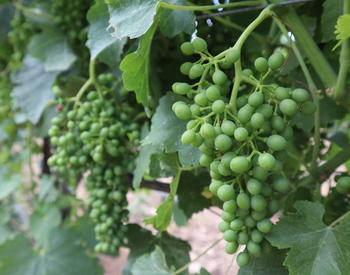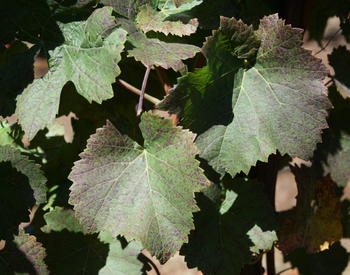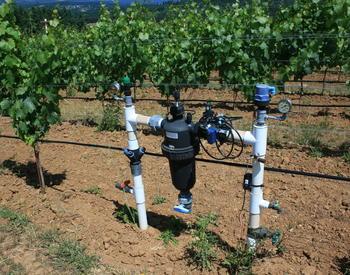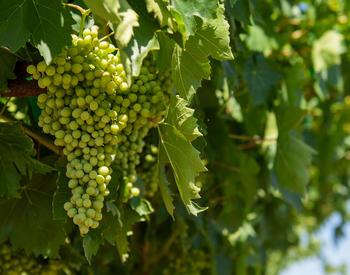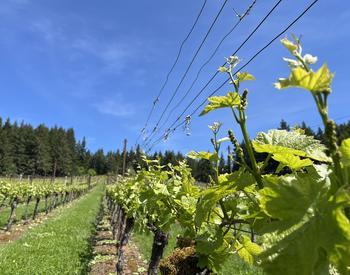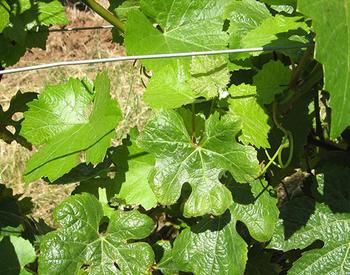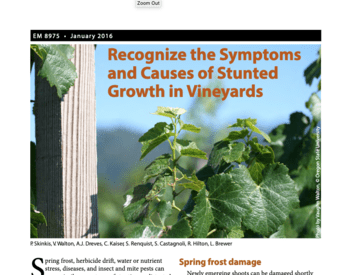Transcript
00:00 Patty Skinkis
This is the High-Res Vineyard Nutrition Podcast Series, devoted to helping the grape and wine industry understand more about how to monitor and manage vineyard health through grapevine nutrition research. I am your host, Dr. Patty Skinkis, Professor and Viticulture Extension Specialist at Oregon State University.
00:22 Patty Skinkis
Crop yield is the metric by which all economic evaluations are based. And in the wine grape world particularly, producers agonize about yield seeking to quantify it to adjust it make sure that we're reaching targets. However, not a lot of research really helps us understand the impact of nutrition on yields from the economic standpoint. Yes, we generally know that optimum nutrition is critical for fruit yields namely good fruit set and ensuring a healthy canopy to ripen fruit. However, we don't have a good idea of how much we need to apply of a nutrient or how incremental gain in nutrient additions will lead to a yield and quality gain at the end of the season. Luckily, we are addressing this question as part of the High-Resolution Vineyard Nutrition Project, and with us today is Alejandro Abarca, a graduate research assistant and PhD candidate here at Oregon State University, who's working with Dr John Woodill and I to tackle this question about economics of vineyard nutrition management.
01:26 Alejandro Abarca
Happy to be here, Patty.
01:27 Patty Skinkis
Well thank you for joining us. To start out with, you know, I've been working with you and John Woodwill as well. But I want you to give us an idea of who you are and how you got into economics research and specifically in this project.
01:46 Alejandro Abarca
Sure, not a problem. So yeah, super happy to be here, and well first of all I'm Costa Rican. I was born and raised there I did my undergraduate studies in Costa Rica. Later on in life I did my master's in Canada, and then I came back here to the to the Pacific Northwest to Oregon State University to get my PhD in applied economics. How I got into economics research-- you know, it's funny. In general, I got into economics because when I was in high school, I just had this idea that economists are working in finance, they're working in banking and have a lot of money. That sounds fun! And thankfully I was wrong in a way you know. I was like “oh thank god” they don't only work with banks and numbers and money you know they actually do a bunch of other stuff. And I kind of fell in love with it. We ask questions about income inequality. We ask questions about pollution, how different public policies, how different things in our life affect us you know. Because at the end of the day what economics is the discipline that studies human tradeoffs right? That's usually between money, right? Like how much something is costing, how much money you have to give but at the same time you can make tradeoffs in other things, you know from how many hours you decide to work in a day, how much pollution you're going to create if you're a company or how much nitrogen you're supposed to put in your wine. You know, if you want to increase your wine yield and all these things. So, I just found fascination in these types of questions and methods and well here I am.
03:19 Patty Skinkis
Yes, the economic tradeoffs. I like that because that is oftentimes, for a producer, is what they're figuring out. And that's where we have a real challenge in viticulture research or even enology research, as we try to isolate something and it's part of that bigger system. It's hard to quantify that tradeoff. So, I want you to tell us a little bit about how you joined up with this team in the High-Res Vineyard Nutrition Project.
03:48 Alejandro Abarca
Absolutely. So, as I said, I'm a PhD student here at the department of the applied economics here at Oregon State University. Essentially, one day we got this email by these researchers working in wine saying “Hey I would like to hire one of these students.”This researcher is John Woodill you know. What he was looking for was someone who could wrangle data who could understand the econometrics that means the statistics that we use in economics to measure these tradeoffs and that was also very comfortable with working with new data, interesting data just to create interest in visualizations or interesting data analysis. So, I got hired by him and ever since I've been one of the persons along with him that we're in charge analyzing this data trying to isolate these effects from these nutrients on what is the effect of these nutrients in yield. Also providing information that is very valuable for stakeholders within the wine industry.
04:43 Patty Skinkis
Can you tell us a little bit about the main goal is of your part of the research and the main question you're addressing.
04:53 Alejandro Abarca
Absolutely, so our current research deals with two things. First of all, we conducted a meta-analysis of the literature to determine what we know as a field of economics and viticulture (literature). What do we know about the effects of nutrients have in grapevine yield. So that is one thing that we did. We went over to literature and saw the estimates, what has been done, what do we know and don't know in general. Based on those things, we get a really good idea of what’s available in the literature and what needs to be added. Then we use this data from the Statewide Crop Load Project at Oregon State University, which, by the way, is a fantastic dataset. You know, it is one of these datasets that maybe just to say it out loud, a really interesting thing that we noticed right away from this data set in comparison to things in the literature is how big it is. Something that is really cool about the data that has been granted by this project is that it's what it's called a panel data set. That means that we follow observations over time, so we see what the level of nutrients, yield, and temperature conditions at a vineyard in 2016 and 2018, 2019, 2020 and we do that for also a set of other vineyards. The advantage of repeated observations over time allows us to isolate some effects that previous literature was not able to do or what previous findings have said, as most studies were only observing one year. These values, what other literature estimated, might be contaminated by factors that have nothing to do with what wine growers were doing in that year. It might be just something that has to do with the geography or the quality of the soil you know or factors that do not change over time. Thankfully, because of the data that we have we allowed us to control for these things and actually consider them in our analysis.
So, the second part of this project like besides a literature review is actually coming up with a statistical framework to understand what is the best way to measure these tradeoffs. Okay. So, if we have more nitrogen, more boron, potassium, etc. What will that do to the yield at the end of season? If we have more rain during the growing season, what is that going to do to yield? If we have rain over the vintage over the last months before harvest, what is that going to do? While we estimate these effects while isolating all the other factors that could also be taking place into these things such as managerial decisions, weather, geography, etc. So, I would say like just to summarize our project in saying that we explored what the literature says but also adding to the literature. Thankfully we have really good data set that allows us to contribute to it and to tell future research how we should measure these things to provide better information for winemakers and other stakeholders within the industry.
08:01 Patty Skinkis
Yeah, that's great to hear that the data set is working well for you. As you know, I know that data set very well. For the listeners who might not know about the Statewide Crop Load Project, it is a 10-year project that we conducted here in Oregon. Quite a few producers carried out the yield management research in their vineyards in a replicative fashion. We collected veraison time point tissue analysis as well as yield, pruning weights, etc, that we could use as part of the work that Alejandro is working on.
Can you give us an idea of how you work on data. You know for a lot of people who do viticulture and enology research, we are always thinking growing season. We think tangibly about crop and things we're measuring. But what does it look like when you're working on a data site? Can you give us an idea of the steps in that process?
08:58 Alejandro Abarca
Absolutely. So first of all, this project in particular was very interesting for me because coming from Costa Rica, we don't grow wine. So, this is something that I know nothing about, right? So, what I have to do as an economist, or as an econometrician in this case, is to be agnostic to data as the best way possible and to understand it. So, the first step will be to say like, “okay what type of data do we have?” Okay, we have a panel data set. This is a data set that allows us to track the same observation over time and that allows us to isolate different factors. Okay, that's great. Do we have the data for weather over time? Yes, we do, so we can add to that while controlling for all the other factors. Once we have that. the first thing we have do is see what the literature has done before. We see that the literature usually has said that nitrogen is super important. Okay, let's look at that. Let's look at the marginal effect--that is what would happen if we add an additional unit of nitrogen, like an additional percentage point or an additional kilogram or whatever to average yield. Okay, does it confirm with previous literature or not? Oh yes, it does, okay, so actually this dataset is confirming something that we already know. It’s actually showing us that this is consistent with what we should observe with the literature, and we go by that with variable by variable. Thankfully we have a data set that is tracking the same observations over time, so we can clean for other factors.
Then once we have these first results, we have discussions with experts. You know, like in this particular case, we talked to you actually, and we just tell you, ‘Hey Patty, so we found this. Does this make sense to you, and is this something that is reportable or not?’ Sometimes you tell us like ‘Well this is kind of fishy. This makes no sense. It makes no sense to use this variable or not,’, you know, and that's the way we push forward with the data.
It's not something that you just go in the abstract and you just have it a data analyst that has all these numbers and something comes out of it. No, it's actually a process where you first run a model that you hypothesize is correct. You go and discuss it with someone that actually goes to the field, to someone who has actually talked to winemakers who actually understands the industry, you present these results, you get feedback. Based on that feedback, you go and make even better results. You read just your expectations, you adjust your models, you check the data they have already worked on. Sometimes you can run into situations where you realize, ‘Oh hold on a second, that result makes no sense,’ but it's probably because we were not interpreting the data correctly, you know. So, it's just a back-and-forth kind of project, a cut process I would say. Overall, that's the way we approach these types of problems and how we work with data.
11:46 Patty Skinkis
I know that you also worked on a number of other data sets too. Can you talk about a few of those that came in within the HiRes Vineyard Nutrition Project?
11:54 Alejandro Abarca
Yeah, so besides the data that we use from Oregon State University, we also have datasets from some other vineyards in Oregon, which also have other types of wine (grapes), including Chardonnay, Pinot Noir, and Chardonel. And these are data sets that try to collect the same type of information. So, the challenge over there is to see up to what they're homogeneous right? Because at the end of the day, the data analysis or the results of the outputs that you can get over analysis also depend on the quality of data. I'm not saying that the data that we were given is bad. What I'm saying is that there's work that has to be done in order for it to be homogeneous. And that's a work that takes time, you know, and it's somehow challenging, and sometimes you got to ponder yourself like, hey these people are doing their best job at collecting data, but did they actually mean the same what they were collecting this variable, or if this variable is missing, can we approximate it with some other things? Yeah, so the other types of datasets are essentially datasets that are at least a subset of the dataset used from Oregon State University, but they try to point out to the same type of variables which are variables that try to collect information on the vine tissue nutrients that are within vineyards and the yield. And when it comes to data about weather, we use the PRISM data which is data that is also provided for Oregon State University
13:35 Patty Skinkis
For those who are listening that aren't aware of PRISM. It's a large climate database that's hosted by Oregon State University, but it's used worldwide as a resource for climate data. So, yes, we're using a lot of other data that's being generated within the HiRes Vineyard Nutrition Project to improve the model or expand the model. So, I know Paul Schreiner at the USDA-ARS here in Oregon as well as Cornell and UC Davis have also included data sets. What are the major findings that you've found in the model that you've developed?
14:12 Alejandro Abarca
Yeah, so the model that we end up using is a model that explains yield based on nutrients that are found in the leaf. The reason why we're focusing on leaf is because the literature suggests that it is the best predictor for yield instead of using petiole. And we are also considering precipitation at the growing season that is from April to August and precipitation over harvest from September to October and temperature during these two time points. The other variables that are considered there--I'm going to explain them a little bit. It's something that within the statistical literature we call them “fixed effects.” I'm going to get to that in a second, but essentially to talk about the findings, the first finding we find is that nitrogen is super important. This is something that we already knew from the literature, but thankfully it's something that we can confirm with this model. To give you a number more specifically, what we find is that at the end of season, having an additional percentage point of nitrogen in leaf blades increases yield by 24%, so that is very important. We also find that when it comes to potassium, it has a positive effect of 18%. So, if you could increase the amount of potassium by one percentage point in your grapevine leaves, that would lead to an 18% increase in yield. We also find that precipitation and temperature during the growing seasons have positive effects over yield. They're not as important as the effects of precipitation and temperature over harvest. But, what is also interesting is that over harvest, the effect that precipitation and temperature have are negative, right? Which is actually something that is expected, right? You don't want a lot of rain during the growing season, but having rain at the end of the season could actually lower the yield that you have. So, what is very interesting in this modeling is--and now I'm going back to the idea of fixed effects, is one thing that we do with the data in econometrics is that we “demean” the data. We basically remove the mean from every variable. So, what does that do? Because when you think about it, any variable over time, when you track an observation over time can be composed of two things. Things that change in every single period but things that do not change over time. So, for instance, a vineyard does not change its location over time. You know, if the vineyard is right next to your mountain, then it’s right next to a mountain. A vineyard will always be in the same county. There are many other characteristics like that. So, when you demean the data, we remove the effects from things that are constant over time. The coefficients or the variables that we are estimating the effect of these variables on yield. Essentially, the effect that is removed after taking the consideration of these variables that do not change over time. So, even if you have a vineyard that you know they have a philosophy when it comes to the management of the vineyard or the way they do things around irrigation, something that hasn't changed over time. Something that is also considering the model even if we cannot model for that explicitly. That is one of the beautiful things that Econometrics has and on top of that another thing that we use in the model that is also very interesting is how one thing that happens with weather data is how erratic it is. That doesn't mean that it's badly measured. It's just that you know one day it could rain some other day doesn't rain you know, temperature can have spikes or lows or whatever. So, one thing that you can do to basically remove that noise that comes over time that is just noise. It doesn't really explain anything fundamental. We can remove that by adding time trends, you know, they basically say all that effect that comes from all these noisy variables, we're going to capture them here. So, this is all just to tell you that this effect that we find in nitrogen, potassium, precipitation, and temperature are effects that come after cleaning from effects that come from noise and from things that do not change over time. In comparison, and going back and just giving credit to this fantastic data set. This is something that previous literature could not do, right?
In previous literature, authors would only compare things that happen from one year to the next, or they only followed one vineyard or we're only talking about one vineyard that was treated differently over time. but that vineyard is not being compared to other vineyards as well. Whereas this project allows us to compare vineyards but also the differences of these vineyards over time while taking away the effect from things that do not change over time and things that are very noisy.
18:53 Patty Skinkis
I think that's a great recognition to the variability. A lot of times people who are doing research say they want to avoid all variability. In this case, the variability is part of what we can explore or exploit in the dataset.
That’s one thing as I've talked to growers who I have done research with. I often have to explain that having the variability is a good thing. and in modeling that is what we need, we can't model something that's completely consistent all the time.
One of the things that I know that you're working on is a decision support tool from this model. Can you describe that for us a bit and what you envision and what might be able to be something that growers can look out for or producers can look out for in the future.
19:38 Alejandro Abarca
Absolutely, so this decision support tool is something that, again with the leadership of John Woodill, we have created. It’s called a decision support tool but in practice is an app. What this app does, it takes the information that we have gathered from this project and it implements the model that we already have--this yield model. So, what does it do? It does two things. First of all, if you're a winemaker or a stakeholder, you can get estimates at the end of season for what your yield is going to be depending on the value of your vine tissue nutrients and also depending on how weather is suspected to change over next year. So, the basic idea is--we have all of this data that is fantastic. It has great variability, it’s data that has compared within the same vineyard but also between vineyards. Okay, so the coefficients that we have here, the estimates that we have here are very representative of the nature of vineyards here in Oregon. And the basic idea is that at the best, at the perfect version of this app, what we would expect is that a winemaker or any stakeholder within the industry, is able to input data and that it os going to give them a prediction of what is going to happen within their vineyard. But at the same time, the other thing that this app this decision support tool is doing is also showing how the data looks overall, right? So, maybe a vineyard [grower] can realize like oh okay I had really decent yield last year but as I can see my levels of nitrogen with respect to other farms or to the over to the average level of nitrogen in the Willamette Valley is lower. Perhaps I could reshuffle my nutrients, I could change the way I'm growing vine, or I could reconsider the ways how I'm doing what I'm doing, right? And at the same time, it would also allow them to see trends over time. They would see like oh okay so in years where we had a lot of rain during the growing season that was kind of bad you know. Or years that were really dry like we find that this is going to happen to yield. So, at the end of the day, besides us creating an academic article, that would give us, that would create contributions to the overall literature or how these nutrients affect yield. We want to make these predictions and this knowledge publicly accessible and really easy for winemakers or for other stakeholders to be like hey, we really need to have an idea of what's going to happen to the yield of her vineyard. Oh, very easy: you just go to this app, you input this data that you already have an idea of how it's going to look like and that's going to give you a number. And on top of that, that app is going to give you a statistical analysis of how things are going to loo, or perhaps it might give you an idea of how things can be improved. Another one of the things that we want to add to the app in the near future is besides a model that estimates the yield, a model that estimates quality of wine. So basically, you can have two things, right? You can decide whether you should go for yield or for quality? Or how those two things are intertwined. So, in general just to give a very brief answer-- the idea of this decision support tool is just to provide the most information, not keep the information just to the academics or to scholars or data analysts. This is good for industry. Industry should use it, and we should make it as easy as possible. You can just log in, put in your data, and then that gives you a number that you can work with and move forward with your production. That's what it is.
23:13 Patty Skinkis
That's what I really appreciate working with both you and John Woodill, is that is something that you automatically do. And oftentimes, I’m here to tell you there's a lot of people who just there their eyes on the prize of an economic paper that anybody would have to be deeply into that discipline to understand what it means and not really mindful of wanting to make something available. And I know that there might be skeptics out there who are hearing about this and saying well there's no app that can really tell me all of these details and we recognize that, but they can provide some idea and get you in the ballpark, and it's better than having nothing and you know and I think that's what's really cool and luckily there's not a version available for you to see today at the time of this recording. But I've seen a beta version and we've been able to, you know, put it in front of growers in some of our meetings and get some input and ah basically the type of data that you're talking about inputting are the nutrient analyses that you get back from your leaf blade or petiole analysis from the lab. You know, a lot of times people will send me their results and say “what does this mean?” and so now I can say put it in the app and you could see what you are going to how it might impact your yields and one of the things I think is important to recognize here is that, I know when we first talked about this with growers, the immediate response was: “oh great! So how does that equal How much nitrogen I have to put in my vineyard?” So, we cautioned about that and, you know we're talking a unit increase in your tissue results and how it might impact your yield. It's much too complicated, right now at least, to get to that point of ah but we're still considering that um as a whole ah High-Res Vineyard Nutrition Project team, how we might make that additional step. But at least, I think from this point this is the first time I think I'm aware of any viticulture type research being done where we can then produce an app that can be used.
25:21 Alejandro Abarca
That's true. I completely agree with everything you're saying, but what I would add to that is that you know this is a curse of having good data. Once you find something with the data, people start asking more questions, and it's a never-ending process, but it’s healthy as long as you allow discussion. As long as you say this is the best number we can come up to, I know you want this other number, but let's start with this one, and once we get that other number, more people are going to demand another number, and it just goes like that. You know, that's just a way how any statistical analysis works. But, thankfully and going just full circle with the type of data [we have in this project] is super high quality. It is the best estimates that we can find, and as you said, we are not aware of another tool like this like anywhere. We've checked, and at the same time the dataset that we have here, it in comparison to other datasets that we've seen is a monster data set like having the ability to just track the same vineyards over time allows us to do a lot of things, so it's a good number. It's a good number to start with, and if you want to get anywhere, you start with one discussion with one conversation and at least we're putting that forward.
26:36 Patty Skinkis
Absolutely, so what do you think are the next steps for or further directions as you continue to work on this project? What’s on the horizon that we should know about?
26:44 Alejandro Abarca
Well, immediately we're also very interested in seeing the effects of these things on quality, which I briefly mentioned already for the app--that we also want to add for the decision support tool. But another thing that we are interested in studying is the tradeoff between yield and quality. So we already know that there is some literature that says that such thing does not exist from a viticulturist perspective, but there might be a tradeoff at the economic perspective because it's not like the problem that is faced for a wine grower. Within his or her farm is not the same as the one that he or she is facing in the market, right? Because part of the thing is that the price that you set on your bottle of wine is a signal of the type of quality that people should expect, right? Or the price that you can offer or the price that you could demand to be paid by someone else, right? So, one thing that John [Woodill] and I were doing is we're trying to analyze this to basically understand all these variables that basically explain quality and explain yield. But at the same time, what is the right combination of factors that would allow you to get the best trade-off the best bang for your buck? When it comes in terms of you maximizing your profits or in terms of you maximizing the amount of things, the amount of bottles that you want to sell in the season. So, we really want to explore that. We have gotten a lot of interest from the part of winemakers in general, and we think it's a really interesting question.
This is a question that is prevalent within something that is called an Economics Industrial Organization, which is just a field that studies how markets are created and how prices and quantities are defined. Well, we're taking that debate to wine economics because we think it's super interesting and we think it's very useful. Because we think that people in general are interested in seeing this trade-off between the quality of wine and the yield that it produces, so that is one thing, and we want to incorporate all these things within the decision support tool because, again, the more information we can provide to wine growers and stakeholders, the better. So that's where our project will lead us next in the upcoming months.
28:53 Patty Skinkis
Yeah, and that is a wonderful future because that's what we always struggle with-- in research and also in industry-- is not knowing how to how to define quality. Therefore, we have troubles with the tradeoff. Now, like you just said at the bottle price--once you get that far, it’s easier to figure out the cost of production and all those sorts of things, but even within the production system especially as labor cost increase and product costs increase more and more, we have to figure out what to cut back on and what to refine. And I'm hopeful that this project will help with that. It is really hard. I don't think there's many options out there for a decision support tool to figure out those tradeoffs. So, I'm really excited to see where the project will take us, and it's been really fun having you in the project. Now, I want to ask a fun question. I know you've worked in more than just wine grapes, like you said in the beginning. But what is the most interesting topic that you have worked on thus far.
30:06 Alejandro Abarca
That I have worked on…[thinking], Wow. I can tell you the most exciting one. So when I was in Costa Rica, I used to work for this office. Basically, I was the economist at that institution that basically managed all the money that was used for social programs in the country, and we faced a problem. The problem is that we had around 2% of the GDP in terms of money it's a lot of money. The issue is that there's a lot of people for which we don't have income data, and if we don't have income data, we don't know how poor they are, right? We don't know if people actually need scholarships or if they need house subsidies or all these things, right? So, one of the things that my former boss told me is, ‘do you think there's a way to fix this is—is there a way to estimate income?’ I came up with two algorithms we charge a series of steps, and I programmed them statistically to basically say if you have these characteristics under these parameters under this period of time, it is expected on average that you will have this income or this other income or whatever. Those algorithms basically generated predictions on how people should be given social programs. There were three algorithms that were being used in Costa Rica to determine income thresholds for people, and two of those were mine. So, I'm pretty proud of that work. In reality, you know and in the spirit of it, it’s not different from what we're doing here. We're predicting something. We're trying to find the most important variables that allow you to do this. So, it’s very beautiful in the sense that you know, when you think of Econometrics, or you think of this type of data analysis, everything has the same spirit. You just think of we're trying to predict this. And then you ask yourself like okay but there are other factors that could make you could create noise and measure in this, how do we clean for those things, you know, and you move from there, and again you go and talk to stakeholders. I had to talk to ministers, I had to talk to people who were going to the field and trying to find these poor people or whatever. And yeah, I think that would be the most exciting type for work that I did. I’m really proud of it, and thankfully, I still work in things that are very related to it.
32:36 Patty Skinkis
That’s very cool. I like the analogy to how it's the same sort of process that's used in a different system. So, when you do this work, are you ever really surprised by some of the factors? In your understanding, you just said, ‘Wow I would have never guessed this.’
32:55 Alejandro Abarca
Yeah, so one of the fun things that happens is that sometimes you get a factor that tells you this is a very important variable, but it has the wrong coefficient, like it should be a positive effect, but it says that it's a negative effect. So, let me give you an example. A variable in Costa Rica that is thought to determine how rich you are is related to the number of people that are living in your household. Which doesn't make sense because you would think the more people, the poorer you should be. Well, the thing is cultural. Latin Americans like to live with our family, you know and once you live in a household, you are more likely that you work. There are these networks within the household that allow you to produce more income. So yes, in theory you would hypothesize, the more people the poorer the household but not in this case. In this case, what happens is that more people they're contributing more, so the algorithm would tend to predict that correctly, by the way. That on average the houses that only had three people were poorer, and the reason is simple. They just had what in economics we would call this, that there was there less labor resources to be used in the household to generate income. An that is like one of those things that you see it at first and you go, hold on--is the data wrong? and then you start thinking about it's like no, it's not wrong. It's telling me a story that I was not thinking about, and I think going back full circle to this project is like you got to be agnostic with the data. You can have the best data in the world and still get the biggest surprise ever. So, the right way of dealing with these things is, let's do the best thing we can and see what we get. Let's interpret it and let's go and talk to an expert that is not you. So, this is also like a common trade in academia, right? You know this very well like it's so important to discuss your findings with other people. If you only talk to yourself and if you only look at results by yourself, you believe that you're smarter than what you actually are, and you're prone to make mistakes. So, I think that's the right way to go on about with these kinds of things.
35:04 Patty Skinkis
Well, that's a great summary of why we're doing this podcast. It is to get the information of all of the people who are working on these projects to stakeholders and the public who are interested in learning about it and to get the feedback and their perspectives and to know that this research team. You know, you can't do research in a vacuum, and working with the diverse group of people that we do-- it's been really fun.
35:34 Alejandro Abarca
Oh, super fun and cool. You know—the thing is that is a general rule. The more eyes the better. You know what mean? You get more insights you get more perspective and it's just funnier.
35:44 Patty Skinkis
Well, Alejandro, thank you so much for joining us today and for sharing information about your research. I wanted to welcome all of you listening to learn more about the HiRes Vineyard Nutrition Project on our website, https://highresvineyardnutrition.com.
35:58 Alejandro Abarca
Thank you.
What is the economic value of making good farm management decisions? In this episode, Alejandro Abarca, Graduate Research Assistant and PhD candidate at Oregon State University, describes research conducted to quantify economic value of vine nutrient management using grapevine tissue nutrition data and end-of-season yields to develop a model to help predict yield impacts in the future.

